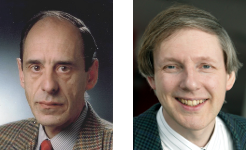Advances in nanomaterials

Karlsruhe Institute of Technology
See also the Thematic Series:
Advances in nanomaterials II
See videos about nanomaterials at Beilstein TV.
Advances in nanomaterials
- Herbert Gleiter,
- Horst Hahn and
- Thomas Schimmel
Beilstein J. Nanotechnol. 2013, 4, 805–806, doi:10.3762/bjnano.4.91

Structural and electronic properties of oligo- and polythiophenes modified by substituents
- Simon P. Rittmeyer and
- Axel Groß
Beilstein J. Nanotechnol. 2012, 3, 909–919, doi:10.3762/bjnano.3.101

Hydrogen-plasma-induced magnetocrystalline anisotropy ordering in self-assembled magnetic nanoparticle monolayers
- Alexander Weddemann,
- Judith Meyer,
- Anna Regtmeier,
- Irina Janzen,
- Dieter Akemeier and
- Andreas Hütten
Beilstein J. Nanotechnol. 2013, 4, 164–172, doi:10.3762/bjnano.4.16

Plasticity of Cu nanoparticles: Dislocation-dendrite-induced strain hardening and a limit for displacive plasticity
- Antti Tolvanen and
- Karsten Albe
Beilstein J. Nanotechnol. 2013, 4, 173–179, doi:10.3762/bjnano.4.17

Grain boundaries and coincidence site lattices in the corneal nanonipple structure of the Mourning Cloak butterfly
- Ken C. Lee and
- Uwe Erb
Beilstein J. Nanotechnol. 2013, 4, 292–299, doi:10.3762/bjnano.4.32

Grating-assisted coupling to nanophotonic circuits in microcrystalline diamond thin films
- Patrik Rath,
- Svetlana Khasminskaya,
- Christoph Nebel,
- Christoph Wild and
- Wolfram H.P. Pernice
Beilstein J. Nanotechnol. 2013, 4, 300–305, doi:10.3762/bjnano.4.33

Antiferromagnetic coupling of TbPc2 molecules to ultrathin Ni and Co films
- David Klar,
- Svetlana Klyatskaya,
- Andrea Candini,
- Bernhard Krumme,
- Kurt Kummer,
- Philippe Ohresser,
- Valdis Corradini,
- Valentina de Renzi,
- Roberto Biagi,
- Loic Joly,
- Jean-Paul Kappler,
- Umberto del Pennino,
- Marco Affronte,
- Heiko Wende and
- Mario Ruben
Beilstein J. Nanotechnol. 2013, 4, 320–324, doi:10.3762/bjnano.4.36

Ferromagnetic behaviour of Fe-doped ZnO nanograined films
- Boris B. Straumal,
- Svetlana G. Protasova,
- Andrei A. Mazilkin,
- Thomas Tietze,
- Eberhard Goering,
- Gisela Schütz,
- Petr B. Straumal and
- Brigitte Baretzky
Beilstein J. Nanotechnol. 2013, 4, 361–369, doi:10.3762/bjnano.4.42

Porous polymer coatings as substrates for the formation of high-fidelity micropatterns by quill-like pens
- Michael Hirtz,
- Marcus Lyon,
- Wenqian Feng,
- Andrea E. Holmes,
- Harald Fuchs and
- Pavel A. Levkin
Beilstein J. Nanotechnol. 2013, 4, 377–384, doi:10.3762/bjnano.4.44

In situ monitoring magnetism and resistance of nanophase platinum upon electrochemical oxidation
- Eva-Maria Steyskal,
- Stefan Topolovec,
- Stephan Landgraf,
- Heinz Krenn and
- Roland Würschum
Beilstein J. Nanotechnol. 2013, 4, 394–399, doi:10.3762/bjnano.4.46

Magnetic anisotropy of graphene quantum dots decorated with a ruthenium adatom
- Igor Beljakov,
- Velimir Meded,
- Franz Symalla,
- Karin Fink,
- Sam Shallcross and
- Wolfgang Wenzel
Beilstein J. Nanotechnol. 2013, 4, 441–445, doi:10.3762/bjnano.4.51

Plasticity of nanocrystalline alloys with chemical order: on the strength and ductility of nanocrystalline Ni–Fe
- Jonathan Schäfer and
- Karsten Albe
Beilstein J. Nanotechnol. 2013, 4, 542–553, doi:10.3762/bjnano.4.63

Deformation-induced grain growth and twinning in nanocrystalline palladium thin films
- Aaron Kobler,
- Jochen Lohmiller,
- Jonathan Schäfer,
- Michael Kerber,
- Anna Castrup,
- Ankush Kashiwar,
- Patric A. Gruber,
- Karsten Albe,
- Horst Hahn and
- Christian Kübel
Beilstein J. Nanotechnol. 2013, 4, 554–566, doi:10.3762/bjnano.4.64

Spin relaxation in antiferromagnetic Fe–Fe dimers slowed down by anisotropic DyIII ions
- Valeriu Mereacre,
- Frederik Klöwer,
- Yanhua Lan,
- Rodolphe Clérac,
- Juliusz A. Wolny,
- Volker Schünemann,
- Christopher E. Anson and
- Annie K. Powell
Beilstein J. Nanotechnol. 2013, 4, 807–814, doi:10.3762/bjnano.4.92

Self-organization of mesoscopic silver wires by electrochemical deposition
- Sheng Zhong,
- Thomas Koch,
- Stefan Walheim,
- Harald Rösner,
- Eberhard Nold,
- Aaron Kobler,
- Torsten Scherer,
- Di Wang,
- Christian Kübel,
- Mu Wang,
- Horst Hahn and
- Thomas Schimmel
Beilstein J. Nanotechnol. 2014, 5, 1285–1290, doi:10.3762/bjnano.5.142





























































































